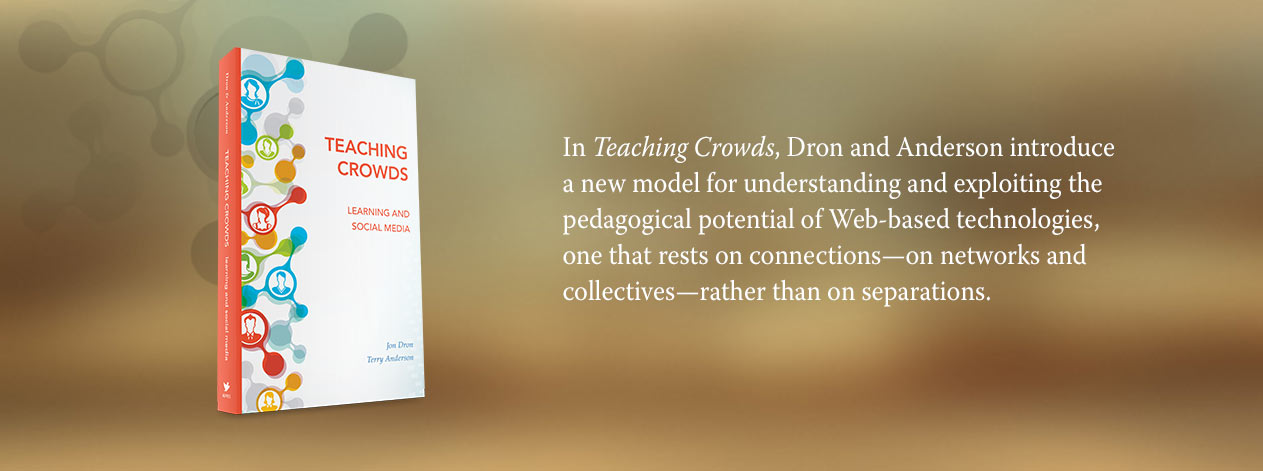Michael Moore’s theory of transactional distance has been used countless times over the past few decades to both guide and explain distance learning transactions. Rather than focusing on physical distance, it describes transactional distance as a psychological and communications gulf between learner and teacher, that may be represented in terms of structure or dialogue, or both.
High structure typically means high transactional distance, while high dialogue generally equates to low transactional distance. As Saba & Shearer discovered (since confirmed and explained by Jon Dron) the greater the structure, the lesser the dialogue, and vice versa. This is down to control: the more structure, the more the teacher controls the learning trajectory of the learner. More autonomous learners are more in control in general. The more dialogue, the more that control comes to rest with the learner, because dialogue results in unpredictable paths and diversions from plans that are determined by the learner as much as the teacher. The psychological gulf, however, is an independent issue from that of control. Psychological closeness matters in many ways, from supporting motivation to the value of being engaged in a shared enterprise, in which we learn from and in tandem with others.

The theory makes perfect sense as long as there is a clear distinction between teacher and learner roles in an educational transaction. However, in each of the social forms, anyone can be and usually is a teacher. This includes writers of textbooks, makers of videos, and other creators of high-structure resources as well as any learner engaged in dialogue (mediated or direct) with any other learner. Transactional distance when learning with crowds must therefore be seen as a distributed measure in which different distances occur between different people in a group, net or set (or any combination of them) as well as other resources that they may encounter along the way, such as books, videos, other communities and collectives.
Bearing in mind that every learning transaction will involve a different combination of distances and that any generalizations may be contradicted by counter-examples if you look hard enough:
- In groups, transactional distance in terms of both communication and the psychological gulf tends to be quite low, because they thrive on people talking with one another. Structure may, when imposed by a controlling teacher, be quite high, which can increase the distance. It is normally a very bad idea to impose high structure (teacher control of the learning transaction) while expecting high dialogue, because they are incompatible with one another. Structure, in the sense of a controlled process, is inimical to dialogue. This remains true even when structure is used to guide dialogue, unless control is sufficiently relaxed along the way to allow rich dialogues to occur.
- In nets, the psychological component of transactional distance is more variable, stronger when ties are strong and weaker when ties are weak. None-the-less, with an almost total absence of structure and a great deal of dialogue, the overall transactional distance in a network tends to be very low. Barriers to dialogue are low and, in many cases, it is dialogue that gives a network its form. If we don’t talk with people, they are probably not in our network.
- In sets, the psychological gulf may be very large (larger still than when ties are weak in a network), but the communication gulf may be quite low. This is quite an odd combination, in which people interact without knowing who they are interacting with. Anyone may leave at a moment’s notice and there are seldom ties to hold them, so learner control is very high from the perspective of any individual participant. However, the large psychological gulf makes sustained communication rare (and, if it occurs, it normally signals the start of a network), and makes for great difficulties establishing trust and belief in others.
- Collectives tend to play structuring roles and only rarely involve any psychological ties at all, meaning that transactional distance is typically high when we are dealing with collectives. On the other hand, the communications gulf is a more complex beast, because we may often be members of our collectives and, of course, they arise out of existing social forms so may often occur in combination with richer social ties. Moreover, quite a few allow tuning and adjustment of the parameters in their algorithms, which makes transactional distance complex and a little recursive. Collectives have special value in sets because they can be used to make up for the trust, design or social connectedness that helps to fuel nets and groups.
We discuss transactional distance in chapter 2 of Teaching Crowds, and it makes an appearance in sections of chapters throughout the book, especially in chapters 3-7.
Further reading: The Distant Crowd: Transactional Distance and New Social Media Literacies
![]()

1 Comment